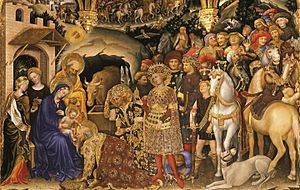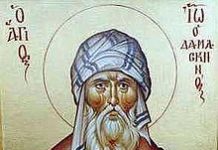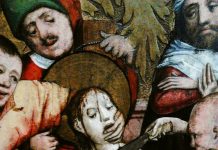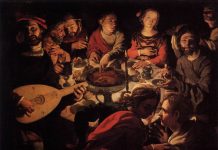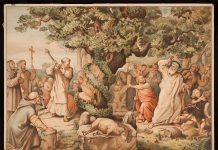Every year, we celebrate the feast of the Epiphany, commemorating the visit of the magi to the Holy Family, on Jan. 6 (hence the 12 days of Christmas) – or the Sunday nearest that date. Among some communities it is customary to give gifts on this day, similar to how gifts might be given on St. Nicholas’s feast or Christmas Day.
This feast represents the time during which the Magi visited the Christ Child and bestowed their gifts on Him, a time separate from the Holy Family’s temporary stay in what was, most likely, a place where animals were kept and fed. This is assumed because Luke 2:7 tells us that the Blessed Virgin Mary laid Jesus in a manger, a veritable food trough – the first and humblest ciborium for the Bread of Life. Matthew 2:11 relates that the Magi find Him and His Mother in a house. This leads us to assume that their visit happens some time after the Savior’s birth.
Extrabiblical traditions, dating back to the 500s, list the names of the magi: Balthasar, Melchior, and Gaspar. For those who have watched Ben-Hur or the stop-motion TV special The Little Drummer Boy, Balthasar (and the others’ names) should be familiar. These three men are saints in the Catholic tradition.
In fact, we receive only glimpses into the lives and mission of the Magi in Scripture. Most of our understanding of the magi comes from a few verses in Matthew and an Old Testament prophecy. Let’s explore what God’s written word and our rich Christian tradition reveal to us about this unique event in salvation history.
What the Bible Says
The whole story of the Magi (sometimes translated “wise men”) and their visit to the Holy Family is recounted in Matthew 2:1-12. In these few verses, we see men who are observant, prudent, persevering, gracious, and obedient to God’s warning in a dream to not return to King Herod. We also read about an unusual star that “stopped over the place where the child was.”
Biblical scholars read between the lines and assume these travelers “from the east” were foreigners, strangers in a strange land, who had to seek the knowledge of local dignitaries and scribes. The plural magi comes from the Greek magos (singular), which has various meanings in antiquity but, when some magi are mentioned in the Book of Daniel, they get lumped together with “wise men” and enchanters. These men would have been well-educated and could have been taught astrology, the belief that the way celestial bodies move dictate what occurs in our world.
In many ancient cultures, the heavens and the gods were inextricable. Genuine astronomy (the scientific study of the stars) and astrology went hand-in-hand. The realm of the stars was unattainable, intangible, and therefore divine. In ancient Egypt, some gods – like Ra – took the form of stars. Babylonia produced some of the finest astronomers of antiquity, but their knowledge of the heavens also fanned their beliefs about the supposed religious significance of stars and planets.
The Catechism of the Catholic Church flatly rejects the superstition of astrology. Stars do not control destinies, no matter their gravity. But God, who in His providence controls the stars, could certainly use them to, as it were, sing the glorious song of His entrance into the world and into the human condition. Like a star or angel, God became a creature. He became Man.
God can even use one man’s folly to lead him to Himself. God could allow astrologers, who rely on faulty or ill-gotten knowledge, to come to the truth just as God allows sin to bring about a greater good (e.g., Crucifixion → Salvation). Nevertheless, the magi’s knowledge was insufficient. Their need for the aid of the chief priests and scribes who consult Scripture (the magi presumably losing sight of their guiding star for a period) shows the universal need for divine revelation in addition to human reason to find peace and salvation. Being observant and knowledgeable aren’t enough. We need to listen to God’s word, attend to His voice.
The verses in Matthew, though short and seemingly cryptic at times, are packed with rich images of fulfillment and foreshadowing. Scripture does not reveal the names of the wise men, how they traveled, or even how many there were. Later Syriac texts like the Revelation of the Magi suggest the presence of 12 wise men. That we do not know exactly how many magi noticed the star and acted on this special sign has piqued the human imagination. For instance, Henry van Dyke’s story The Other Wise Man, a tale of a fourth “magos,” has spurred numerous film adaptations.
Only three gifts, however, are mentioned: gold, frankincense, and myrrh. Gold signifies Jesus’s royalty. Frankincense, or incense, is used in worship, denoting Christ’s divinity. And myrrh, a resin, was also used in worship as well as in embalming corpses; this was a precursor to Jesus’s burial, where myrrh was applied in the embalming process prior to burial (see Gospel of John, chapter 19).
The fact that these wise men are likely Gentiles (non-Jews) is significant. The star carries some weighty symbolism too.
The Significance of the Magi: A Prophecy Fulfilled
In Numbers chapter 24, we hear from a Gentile prophet named Balaam, the same Balaam who beat his donkey for its misbehavior only to hear God open the mouth of the donkey to communicate with him. Balak wants Balaam to pronounce a curse on Israel, but the prophet will only say what the LORD reveals to him. Thus, he delivers several oracles that instead bless the Israelites. The final oracle is traditionally viewed as the prophecy of the magi coming to the King of Israel. In a stream of poetry, Balaam says:
I see him, though not now;
I observe him, though not near:
A star shall advance from Jacob,
and a scepter shall rise from Israel,
That will crush the brows of Moab,
and the skull of all the Sethites…
(Numbers 24:17).
Obviously, the star gets our attention. The reference to “scepter” implies a ruler. But that’s not all. In the next verse, Balaam predicts that “Edom will be dispossessed.” Centuries later, King Herod, who is so anxious about the arrival of the magi and word about this other King, was himself an Idumean, a man from the land of Edom. Knowing this about the prophecy makes Herod even more of a target to be overthrown. His fear and lust for power led him to slaughter innumerable male children, causing the Holy Family to flee to Egypt.
Returning to the prophecy from the Book of Numbers, Balaam is referred to as a “magos” by the Jewish writer Philo. This connection again gives credence to the belief that the Magi in Matthew were Gentiles, like Balaam. And, like Balaam, they did not curse Israel but recognized something magnificent was happening in this foreign land.
The deepest significance of the magi themselves is that they represent the Gentiles, all non-Jews, coming “to do [Jesus] homage.” They are one of the earliest examples in the Gospels of the message that salvation, while it comes from the Jews, is meant for all. Jesus comes to serve both Gentile and Jew alike. In God’s eyes, such divisions do not exist. His love knows no bounds. The magi also show us that even if someone is not raised in the Faith or even if they practice superstition, everyone is still attracted to God, Who is Truth, Beauty, and Goodness. It is in the miracle of Christmas, that God becomes incarnate.
Three Theories About the Star of Bethlehem
To the Gentiles, a star heralding the coming of a King would be quite appropriate. From a biblical perspective, God guiding travelers with a point of light is also appropriate. Jesus was born in an age where many believed it was not uncommon for celestial signs to accompany important historical events (both good and bad), including the birth of a king.
A few prominent examples can be found in ancient Rome, the world power that occupied Israel in Jesus’s day. The Roman historian Suetonius recorded that a portent signaled the birth of Augustus, the future emperor. Again, after Julius Caesar was murdered, a comet appeared, and Augustus took it to mean that his predecessor had become a god. Hence, even to non-believers, a celestial sign was important.
The elements of light and darkness are used throughout salvation history. God creates day and night and the luminaries of the heavens. He appears to Moses in a burning bush. The Psalmist compares God to the sun at its rising. God also uses a pillar of fire to lead the Israelites out of Egypt and toward a place of safety and peace. Similarly, God uses a star to show the Magi the way into a foreign country, leading them to the Prince of Peace. It’s a peculiar guide, halting above the place where Jesus was.
Though the Bible uses the term “star,” theologians have different interpretations regarding what the “star” actually was. Taken broadly, these theories fall into three categories: The star was a physical celestial sign (either a star, comet, or planetary alignment), or it was a supernatural phenomenon or being, or it was indeed a star, albeit one manipulated by an angel. Let’s look at these interpretations in a bit more detail.
The star of Bethlehem could be just that – a star. But, as the creature that swallowed Jonah has been taken to be either a whale or a giant fish, so too the term “star” in the Bible does not necessarily carry the same meaning as the term used by modern scientists. Over the years, scholars have suggested it was a comet or a planetary conjunction.
Especially popular are various theories of a conjunction involving Jupiter. This gas giant, which has been viewed as the “king” planet of our solar system, would be an appropriate sign directing the magi to the King of kings. Astronomer Johannes Kepler (also a devout Christian) believed the Star of Bethlehem could be explained as the conjunction of Jupiter and Saturn – an astronomical event which occurs about every two decades.
If this were the case, then God, in allowing this natural phenomenon to herald the birth of His Son, had worked through secondary causality. If you’re interested in learning more about a natural interpretation of events, I recommend Mpower Pictures’ The Star of Bethlehem in which Rick Larson uses simulations of the stars and celestial bodies as they would have appeared two millennia ago at the time of Christ’s birth. He argues that the star visible to the Magi was a conjunction of Jupiter with a star or Jupiter and the planet Venus. Larson also reads a divine message into the movements of other celestial bodies and constellations like Virgo and Leo. It is all part of God’s plan.
Another interpretation is that the “star” was a supernatural light or the Holy Spirit or an angel. Other biblical passages about stars, when read through the spiritual sense of Scripture, seem to refer to angels. Traditionally, it is held that angels were created before human beings. This is backed by the fact that the stars are created prior to man and woman (see Genesis 1:14-18). In this interpretation, the stars represent the angels. Similarly, at the end of the Bible, in Revelation 12:4, we read that the red dragon’s tail “swept away a third of the stars in the sky.” Revelation uses a lot of symbols. Theologians take this image to represent the devil taking a third of the angels to Hell with him when war broke out. Here again the stars represent angels. So some have speculated that the Star of Bethlehem could also have been an angel, a supernatural being. This sort of symbolism has made its way into Christian fantasy. A prominent example is the personified stars (like Ramandu and his daughter) that appear in C.S. Lewis’s Narnia stories, especially The Voyage of the Dawn Treader.
The third theory regarding the nature of the star combines both the notion of a literal body in space and the supernatural intervention of an angel. Because of its extraordinary behavior recorded in Matthew, many of the Church Fathers believed the star was miraculous: either a star created specifically for this mission or an ordinary star moved out of its usual orbit by an angel. It is the latter notion that Hans Thoma put on display in his painting “Angel with the Star of Bethlehem.” This understanding includes the best of both worlds, as it were – the glory of a star and the intervention of an angel. It’s comparable to the Miracle of the Sun at Fatima, the miraculous movement of our solar system’s star at the culmination of Our Lady’s apparition.
We have seen that there are conflicting opinions about just what the star was. Though they vary, these theories should never divide Christians. When St. Augustine is dealing with a plethora of interpretations of the first few lines of Genesis in his Confessions, he advocates for charity among those who take different stances. He writes, “Amid this profusion of true opinions let Truth itself engender concord…let all of us who, as I acknowledge, discern rightly and speak truly on these texts, love one another and likewise love you, our God, the fount of truth, if truth is really what we thirst for, and not illusions” (Confessions XII.30.41).
In other words, we should be kind to our fellow Christians who have a different interpretation than us. Jesus, Who is the Way, the Truth, and the Life, takes precedence. We share Him. At the end of the day, the Christmas and Epiphany story is about much more than a star. Something greater than the star (extraordinary – miraculous even – though it may be) is here. It is the poor Newborn. Jesus is no ordinary child. He is God, and “God is light, and in him there is no darkness at all” (1 John 1:5b). Let us, like the Magi of old, follow the Light.
Recommended reading/additional sources:
Barber, Michael P. The True Meaning of Christmas. San Francisco: Ignatius Press/Greenwood Village, CO: Augustine Institute, 2021.

